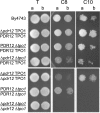Activation of two different resistance mechanisms in Saccharomyces cerevisiae upon exposure to octanoic and decanoic acids
- PMID: 20851956
- PMCID: PMC2976208
- DOI: 10.1128/AEM.01280-10
Activation of two different resistance mechanisms in Saccharomyces cerevisiae upon exposure to octanoic and decanoic acids
Abstract
Medium-chain fatty acids (octanoic and decanoic acids) are well known as fermentation inhibitors. During must fermentation, the toxicity of these fatty acids is enhanced by ethanol and low pH, which favors their entrance in the cell, resulting in a decrease of internal pH. We present here the characterization of the mechanisms involved in the establishment of the resistance to these fatty acids. The analysis of the transcriptome response to the exposure to octanoic and decanoic acids revealed that two partially overlapping mechanisms are activated; both responses share many genes with an oxidative stress response, but some key genes were activated differentially. The transcriptome response to octanoic acid stress can be described mainly as a weak acid response, and it involves Pdr12p as the main transporter. The phenotypic analysis of knocked-out strains confirmed the role of the Pdr12p transporter under the control of WAR1 but also revealed the involvement of the Tpo1p major facilitator superfamily proteins (MFS) transporter in octanoic acid expulsion. In contrast, the resistance to decanoic acid is composite. It also involves the transporter Tpo1p and includes the activation of several genes of the beta-oxidation pathway and ethyl ester synthesis. Indeed, the induction of FAA1 and EEB1, coding for a long-chain fatty acyl coenzyme A synthetase and an alcohol acyltransferase, respectively, suggests a detoxification pathway through the production of decanoate ethyl ester. These results are confirmed by the sensitivity of strains bearing deletions for the transcription factors encoded by PDR1, STB5, OAF1, and PIP2 genes.
Figures







Similar articles
-
New insights into the toxicity mechanism of octanoic and decanoic acids on Saccharomyces cerevisiae.Yeast. 2015 May;32(5):451-60. doi: 10.1002/yea.3071. Epub 2015 Apr 8. Yeast. 2015. PMID: 25773463
-
Membrane stress caused by octanoic acid in Saccharomyces cerevisiae.Appl Microbiol Biotechnol. 2013 Apr;97(7):3239-51. doi: 10.1007/s00253-013-4773-5. Epub 2013 Feb 26. Appl Microbiol Biotechnol. 2013. PMID: 23435986
-
Effects of low temperatures (9-33 degrees C) and pH (3.3-5.7) in the loss of Saccharomyces cerevisiae viability by combining lethal concentrations of ethanol with octanoic and decanoic acids.Int J Food Microbiol. 1997 Mar 3;34(3):267-77. doi: 10.1016/s0168-1605(96)01200-7. Int J Food Microbiol. 1997. PMID: 9039572
-
Novel stress responses facilitate Saccharomyces cerevisiae growth in the presence of the monocarboxylate preservatives.Yeast. 2008 Mar;25(3):169-77. doi: 10.1002/yea.1576. Yeast. 2008. PMID: 18240334 Review.
-
Adaptive response and tolerance to weak acids in Saccharomyces cerevisiae: a genome-wide view.OMICS. 2010 Oct;14(5):525-40. doi: 10.1089/omi.2010.0072. OMICS. 2010. PMID: 20955006 Free PMC article. Review.
Cited by
-
QTL mapping of the production of wine aroma compounds by yeast.BMC Genomics. 2012 Oct 30;13:573. doi: 10.1186/1471-2164-13-573. BMC Genomics. 2012. PMID: 23110365 Free PMC article.
-
Defects in mitochondrial and peroxisomal β-oxidation influence virulence in the maize pathogen Ustilago maydis.Eukaryot Cell. 2012 Aug;11(8):1055-66. doi: 10.1128/EC.00129-12. Epub 2012 Jun 15. Eukaryot Cell. 2012. PMID: 22707484 Free PMC article.
-
De novo biosynthesis of 8-hydroxyoctanoic acid via a medium-chain length specific fatty acid synthase and cytochrome P450 in Saccharomyces cerevisiae.Metab Eng Commun. 2019 Nov 18;10:e00111. doi: 10.1016/j.mec.2019.e00111. eCollection 2020 Jun. Metab Eng Commun. 2019. PMID: 31867212 Free PMC article.
-
Differential adaptation to multi-stressed conditions of wine fermentation revealed by variations in yeast regulatory networks.BMC Genomics. 2013 Oct 4;14:681. doi: 10.1186/1471-2164-14-681. BMC Genomics. 2013. PMID: 24094006 Free PMC article.
-
Transcriptome of Saccharomyces cerevisiae during production of D-xylonate.BMC Genomics. 2014 Sep 5;15(1):763. doi: 10.1186/1471-2164-15-763. BMC Genomics. 2014. PMID: 25192596 Free PMC article.
References
-
- Akache, B., S. MacPherson, M. Sylvain, and B. Turcotte. 2004. Complex interplay among regulators of drug resistance genes in Saccharomyces cerevisiae. J. Biol. Chem. 279:27855-27860. - PubMed
-
- Alenquer, M., S. Tenreiro, and I. Sá-Correia. 2006. Adaptive response to the antimalarial drug artesunate in yeast involves Pdr1p/Pdr3p-mediated transcriptional activation of the resistance determinants TPO1 and PDR5. FEMS Yeast Res. 6:1130-1139. - PubMed
-
- Alexandre, H., B. Mathieu, and C. Charpentier. 1996. Alteration in membrane fluidity and lipid composition, and modulation of H+-ATPase activity in Saccharomyces cerevisiae caused by decanoic acid. Microbiology 142:469-475. - PubMed
-
- Alexandre, H., and C. Charpentier. 1998. Biochemical aspects of stuck and sluggish fermentation in grape must. J. Ind. Microbiol. Biotechnol. 20:20-27.
-
- Bardi, L., C. Crivelli, and M. Marzona. 1998. Esterase activity and release of ethyl esters of medium-chain fatty acids by Saccharomyces cerevisiae during anaerobic growth. Can. J. Microbiol. 44:1171-1176. - PubMed
Publication types
MeSH terms
Substances
LinkOut - more resources
Full Text Sources
Other Literature Sources
Molecular Biology Databases

